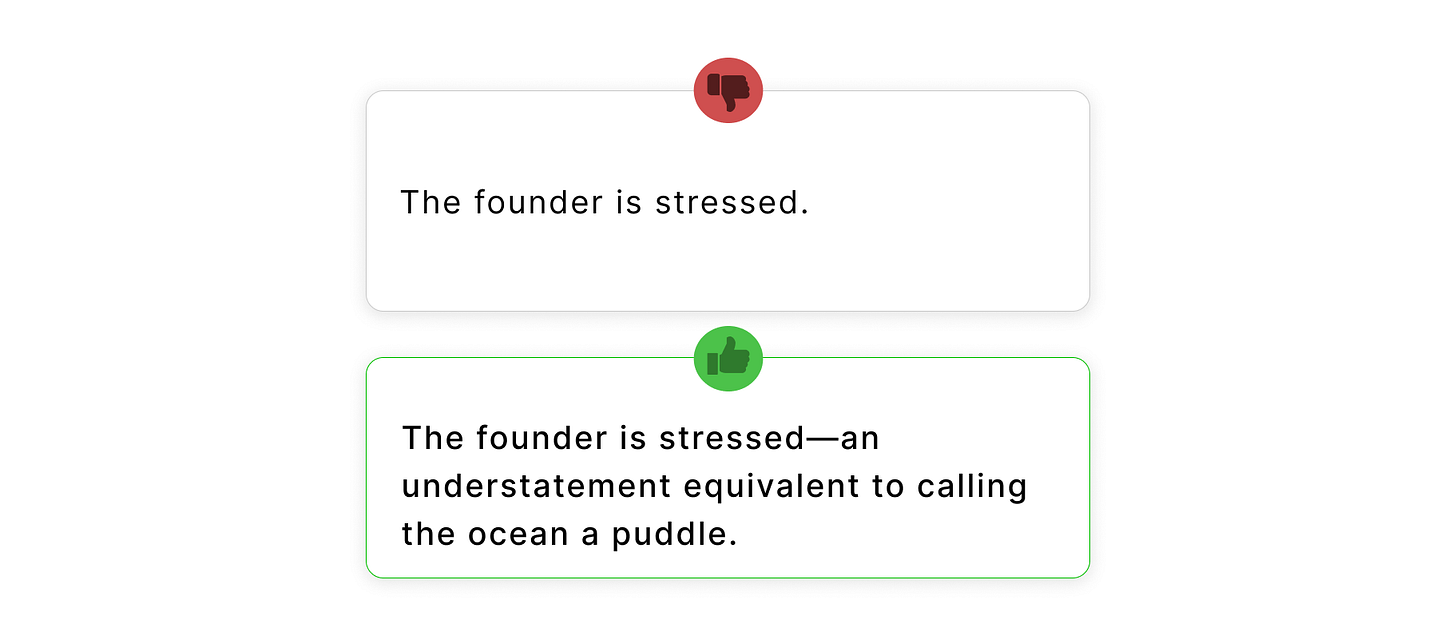10 Literary Devices with Examples
Anaphora, Antithesis, Allegory, Tricolon, and more.
This is a follow-up to my last post: 10 Tips to Improve your Copywriting.
Whereas that one was actionable tips on making content more concise and user-centric, this is nearly the opposite:
Making your content more fun and engaging to read.
This is an art and a science.
Most content is really f*ckin’ boring 😴
To stand the f*ck out, you need to inspire 🤩🤩🤩
First, wtf is a “Literary Device?”
It’s a fancy word for “thing you do to better express ideas, convey meaning, and highlight important themes in a text.”
Some common examples:
Metaphor: Comparing something for effect.
“The startup is a rocket ship"
Simile: Comparing something with “like or “as”:
“Dumb as a sack of hammers”
Alliteration: Repetition of consonant sounds
“Five feisty founders fought furiously”
Assonance: Repetition of vowel sounds
"The keen, deep founder freely speaks about the peaks and valleys.”
But most people know these from school days (or have blocked them out).
So, instead, let’s cover some lesser-known ones that can help make your writing more fun and exciting.
Let’s dive into 10 literary devices with examples of each.
1. Anaphora
The deliberate repetition of the first part of the sentence for emphasis.
Here’s how Justin Welsh used it:
2. Anthithesis
Juxtaposing contrasting ideas, often in parallel structure, to emphasize, create drama, or highlight.
Tip: Doing this right can tell a story of its own.
3. Tricolon
A series of 3 parallel words, phrases, or clauses.
This enhances rhythm and creates emphasis.
Tip: This contains another literary device called “Asyndeton” that leaves out conjunctions (and/or) to improve the rhythm.
Here’s an example shared on marketingexamples.com:
4. Paradox
A statement that contradicts itself but still seems true. Can be intriguing.
Tip: Can be interpreted as the founder being stressed (storm) yet maintaining composure (calm)
5. Irony
Using language that signifies the opposite, typically for humorous or emphatic effect.
Tip: Paint a vivid and colorful image.
6. Catachresis
Purposefully using a word incorrectly, for effect.
Tip: Paint a vivid and colorful image.
7. Pleonasm
Use more words than necessary to convey meaning and emphasis.
Tip: Adds a bit of fun and imagery.
8. Synecdoche
Part is made to represent the whole or vice versa. Below a mouth represents a whole person.
Tip: Try to add fun imagery, but be careful to not make it confusing.
9. Paraprosdokian
The latter part causes the reader or listener to reframe or reinterpret the first part.
Tip: This can either reinforce the original meaning, or make them totally rethink it.
10. Allegory
Narrative or description that has a secondary or symbolic meaning underlying the literal one.
Tip: People love storytelling. Paint a vivid scene.
What’s next?
Literary devices is a tiny piece of the copywriting puzzle. Here are some other articles I’ve written to help take your content to the next level:
10 Ways to Hook People. People won’t read your content if you fail to hook them.
The 10 types of posts and how to use them. Use these to systematize your content creation process.
10 Tips to Improve your Copywriting. Actionable quick wins.
7 Copywriting Frameworks. Make writing persuasively way easier.
Thanks for reading
If you liked this, please click/tap the ❤️ and share it with a friend. It really helps it get seen by more people.
How I can help you grow:
Book a 1-hour consultation call with me. I’ve helped:
1000s of companies define their growth strategy.
100s of people start building their personal brand.
And I run two 7-figure bootstrapped businesses.
Sign up for my premium newsletter.
Work with my ads agency, Bell Curve
😍
– Neal














Yo!